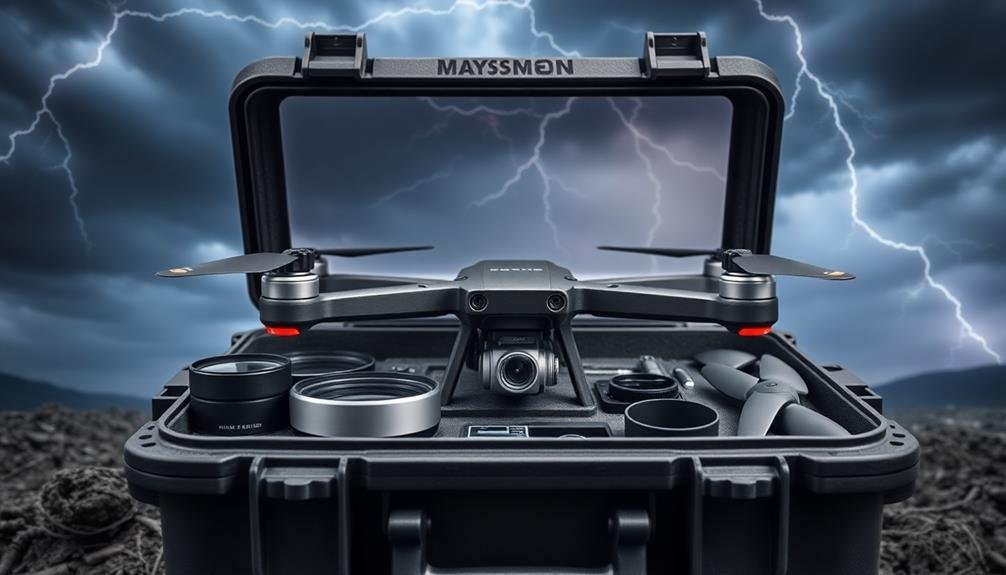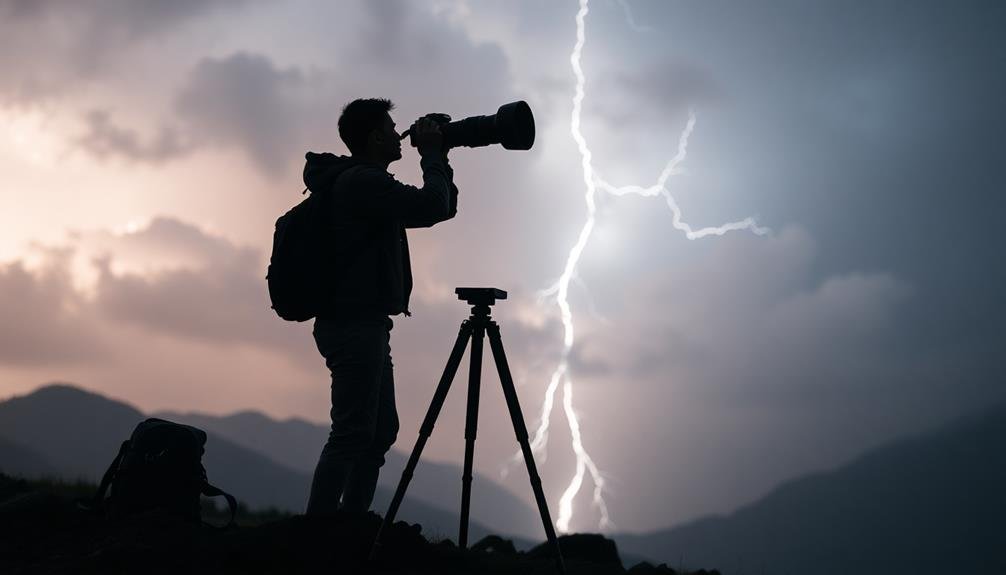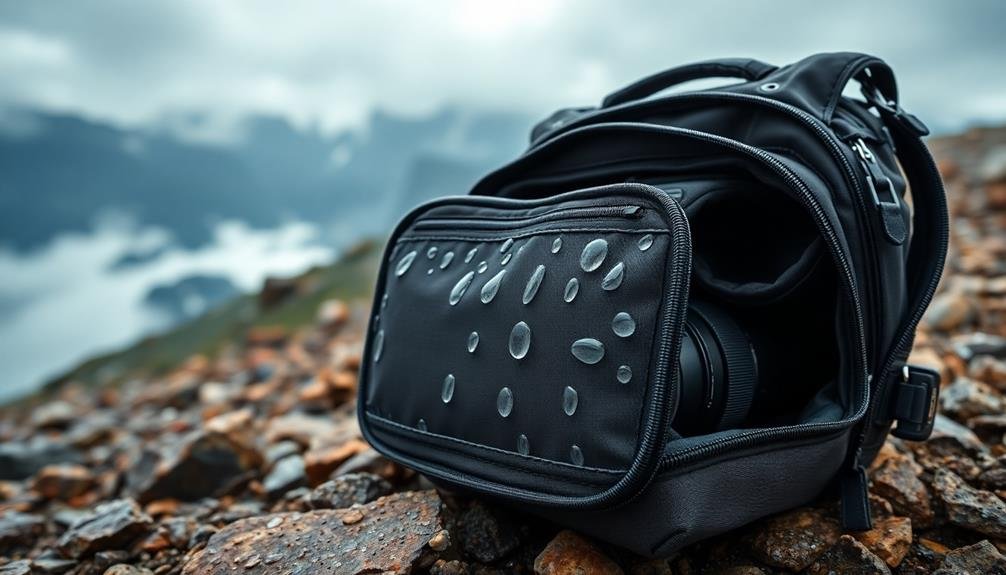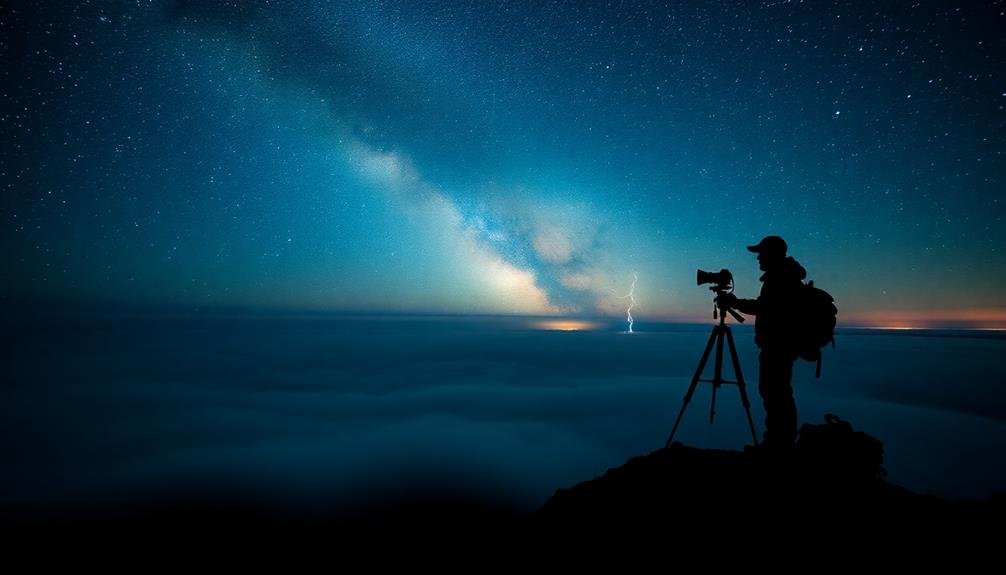For sky photography enthusiasts, weather-proof gear is essential. You'll want a weather-sealed camera body like the Canon EOS R5 or Nikon D850 to withstand harsh conditions. Protect your drone with a high-quality waterproof case rated IP67 or higher. Don't forget all-weather lens protectors with UV and scratch resistance to keep your shots clear. Invest in a durable carbon fiber tripod with weather-sealed joints for stability in any environment. Finally, a moisture-resistant camera bag with sealed zippers will safeguard your equipment during transport. These five key pieces of gear will help you capture stunning sky shots, no matter the forecast. Let's explore each item in detail.
Key Takeaways
- Weather-sealed camera bodies like the Canon EOS R5 protect against dust, moisture, and extreme temperatures.
- Waterproof drone cases with IP67 ratings or higher safeguard drones from rain, snow, and accidental drops.
- All-weather lens protectors with UV resistance and anti-fog coatings ensure clear shots in harsh conditions.
- Durable carbon fiber tripods with weather-sealed joints provide stability and protection in outdoor settings.
- Moisture-resistant camera bags with water-resistant fabric and sealed zippers shield equipment from rain and humidity.
Weather-Sealed Camera Bodies

When it comes to weather-sealed camera bodies, you'll find that they're essential for sky photography in unpredictable conditions. These cameras are designed to withstand dust, moisture, and extreme temperatures, ensuring your gear remains protected while you capture stunning skyscapes.
Look for cameras with robust magnesium alloy bodies and extensive weather sealing around buttons, dials, and compartments. Top choices include professional-grade DSLRs and mirrorless cameras from brands like Canon, Nikon, Sony, and Fujifilm. The Canon EOS R5, Nikon D850, and Sony A7R IV are excellent options that offer superior weather resistance.
Pay attention to the camera's IP rating, which indicates its level of protection against solid particles and liquids. A higher IP rating means better protection.
Also, consider cameras with built-in heaters to prevent fogging in cold conditions.
Remember that weather-sealed doesn't mean waterproof. Always use additional protection like rain covers or underwater housings in heavy rain or extreme conditions.
Pair your weather-sealed camera body with similarly protected lenses to create a fully weather-resistant system. This combination will allow you to confidently shoot in challenging environments, capturing breathtaking sky images regardless of the weather.
Waterproof Drone Cases

While ground-based photographers rely on weather-sealed cameras, aerial photographers need to protect their drones. Waterproof drone cases are essential for safeguarding your expensive equipment from the elements. These cases offer robust protection against rain, snow, dust, and accidental drops.
When choosing a waterproof drone case, take into account the following factors:
| Feature | Importance | Example |
|---|---|---|
| IP Rating | High | IP67 (waterproof up to 1m) |
| Material | Medium | High-density polyethylene |
| Customization | Low | Foam inserts for drone parts |
Look for cases with IP67 or higher ratings to guarantee complete water resistance. Hard-shell cases made from durable materials like high-density polyethylene offer superior protection against impacts. Many cases come with customizable foam inserts, allowing you to create perfect-fit compartments for your drone and accessories.
Don't forget to take into account the case's size and weight, especially if you'll be traveling frequently. Some cases feature wheels and extendable handles for easy transport. By investing in a high-quality waterproof drone case, you'll be able to confidently capture stunning aerial shots in various weather conditions without worrying about damaging your equipment.
All-Weather Lens Protectors

Photographers often overlook the importance of all-weather lens protectors when gearing up for sky photography. These essential accessories shield your valuable lenses from harsh elements, guaranteeing clear shots and prolonging equipment life.
When choosing the right protector, consider factors like optical clarity, durability, and ease of use.
Top-quality all-weather lens protectors offer:
- UV and scratch resistance
- Multi-coating technology for reduced glare
- Quick-release mechanisms for rapid attachment
- Weatherproof seals to keep out moisture and dust
- Compatibility with various lens sizes and brands
You'll find options ranging from simple screw-on filters to more advanced systems with interchangeable elements. For sky photography, opt for protectors that minimize color distortion and light loss.
Some models even feature anti-fog coatings, ideal for capturing misty landscapes or shooting in humid conditions.
Don't forget to clean your lens protectors regularly to maintain peak performance. Carry a microfiber cloth and cleaning solution in your kit for on-the-go maintenance.
Durable Tripods for Outdoor Use

In the domain of sky photography, a sturdy tripod is your best friend. When selecting a durable tripod for outdoor use, you'll want to take into account materials, weight capacity, and weather resistance. Carbon fiber tripods offer an excellent balance of strength and lightweight portability, while aluminum models provide durability at a lower cost.
Look for tripods with robust leg locks that won't slip in wet conditions. Rubber feet with retractable spikes offer versatility on various terrains. Some models feature weather-sealed joints to prevent moisture and dust infiltration.
Here's a comparison of popular outdoor tripod features:
| Feature | Carbon Fiber | Aluminum | Magnesium Alloy |
|---|---|---|---|
| Weight | Lightweight | Moderate | Lightweight |
| Durability | High | High | High |
| Cost | Expensive | Affordable | Moderate |
| Weather Resistance | Excellent | Good | Excellent |
Don't forget to take into account the tripod's maximum height and minimum working height. A center column that can be inverted for low-angle shots adds versatility. Finally, verify the tripod's load capacity exceeds your heaviest camera and lens combination to maintain stability in windy conditions.
Moisture-Resistant Camera Bags

Sky photography's success often hinges on keeping your gear dry and protected. That's where moisture-resistant camera bags come in. These specialized bags are designed to shield your equipment from rain, mist, and humidity, ensuring your camera and lenses remain in top condition.
When choosing a moisture-resistant bag, consider these key features:
- Water-resistant or waterproof exterior fabric
- Sealed zippers to prevent water ingress
- Padded interior compartments for gear protection
- Adjustable dividers for customizable organization
- Built-in rain cover for additional protection
You'll find various styles to suit your needs, from backpacks to messenger bags. Backpacks are ideal for longer treks, distributing weight evenly across your shoulders. Messenger bags offer quick access to your gear, perfect for urban shoots or shorter excursions.
Don't skimp on quality when it comes to moisture-resistant bags. Invest in a reputable brand known for durability and weather resistance.
Frequently Asked Questions
How Do I Protect My Camera From Extreme Temperatures?
To protect your camera from extreme temperatures, you'll want to use insulated camera bags, silica gel packs, and lens warmers. Keep your gear in a temperature-controlled environment when possible, and avoid rapid temperature changes. Use weatherproof covers for added protection.
What's the Best Way to Clean Weather-Sealed Gear After Use?
After using weather-sealed gear, you'll want to clean it carefully. Wipe it down with a damp microfiber cloth, then dry thoroughly. Don't forget to clean lens surfaces and seals. Avoid harsh chemicals and always follow manufacturer's guidelines.
Are There Any Smartphone Accessories for Sky Photography in Harsh Weather?
You'll find several smartphone accessories for sky photography in harsh weather. Consider waterproof cases, clip-on lenses, tripods, and remote shutters. Don't forget power banks and weather apps. They'll help you capture stunning shots in challenging conditions.
How Can I Prevent Lens Fogging During Rapid Temperature Changes?
To prevent lens fogging during rapid temperature changes, you'll want to use anti-fog wipes or sprays on your lens. Keep your gear in a sealed bag when moving between temperatures, and use a lens hood to shield it.
What Safety Precautions Should I Take When Photographing Storms or Extreme Weather?
When photographing storms, prioritize your safety. Stay informed about weather conditions, seek shelter immediately if lightning's present, and don't venture into flood-prone areas. Keep a safe distance from severe weather and always have an escape route planned.
In Summary
You're now equipped with the top weather-proof gear for sky photography. Don't let rain, wind, or harsh conditions stop you from capturing breathtaking shots. With these durable tools, you'll be ready to face any weather challenge. Remember, it's not just about protecting your equipment; it's about extending your shooting opportunities. So gear up, head out, and start capturing those stunning skyscapes in any weather. The perfect shot awaits!

As educators and advocates for responsible drone use, we’re committed to sharing our knowledge and expertise with aspiring aerial photographers.




Leave a Reply